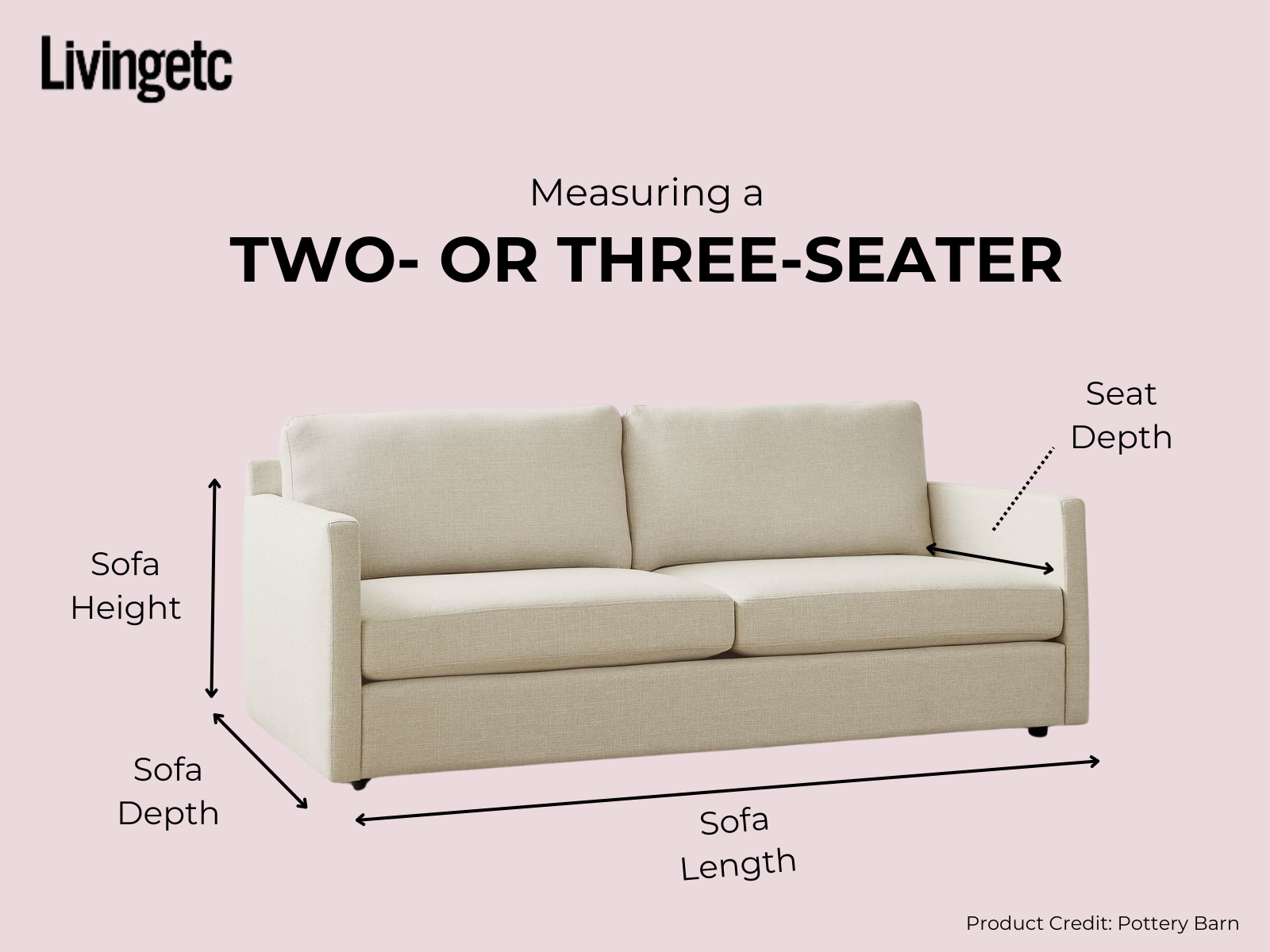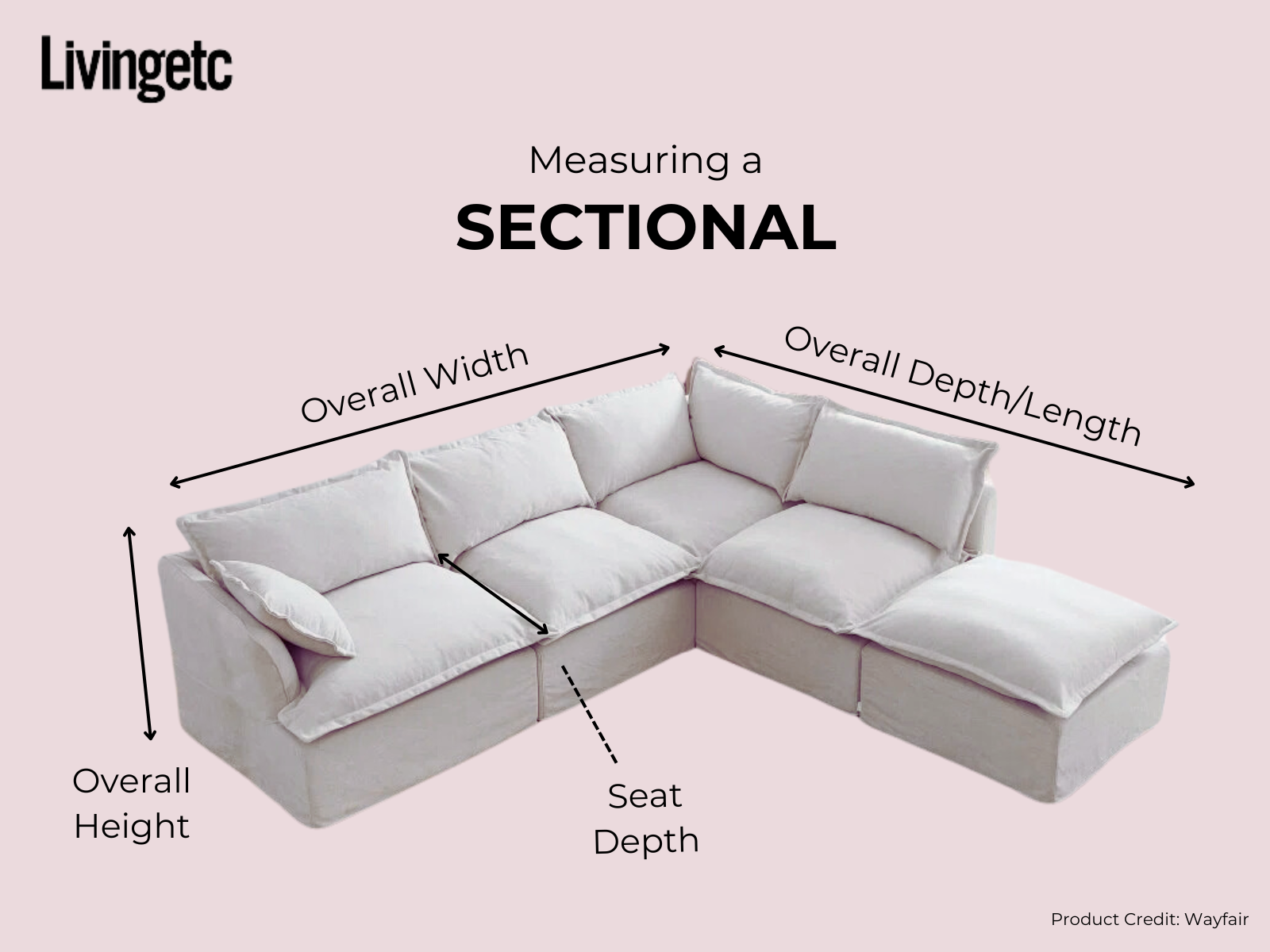
Aside from your bed, your sofa is probably the largest piece of furniture in your home — or, at the very least, the most important. It's where the majority of daylight maxing and relaxing happens. It's where you take house calls and phone calls. And, if you're like me, it's where you binge all 55 episodes in a season of Love Island. Comfort is key, as is fit, shape, and, most underratedly, scale.
So before you invest in a new couch, you should familiarize yourself with sofa dimensions and what they mean — so you can easily and accurately figure out the best sofa for your home. Let's dive in.
Average Sofa Size
Understanding typical sofa sizing is particularly helpful during the sofa-buying process, especially if you’re shopping online. That way, you can compare dimensions across brands with a better idea of what’s standard. You should, of course, measure for your own space first and foremost, but at least you’ll know upfront which styles and lengths to weed out from the get.
"The most common sofa size in the US is typically around 84 inches (7 feet) in length, often referred to as a three-seater sofa," says Mackenzie Collier of Mackenzie Collier Interiors. "It usually has a depth of about 35-38 inches and a height of around 30-34 inches."
When it comes to seat depth and height, however, most sofas "have a seat height of 17 to 19 inches and a seat depth of 21 to 24 inches," adds Anna Tatsioni, lead interior designer and architect at Decorilla Online Interior Design, a 3D and VR design service that connects customers with vetted interiors professionals.
- Loveseats — Loveseats range anywhere from 48” to 72” in length, with an overall depth in the 32” to 40” range (35” to 36” being the most standard).
- Three-seaters — Of the three main couch styles, three-seaters are the most common. These sofas can be anywhere from 70” to 87” long, 84” being the standard, and 36” to 38” deep.
- Sectionals — Sectional sofas are highly customizable, so their sizing varies from piece to piece. That said, width tends to fall within the 90” to 168” range, while length/depth is usually between 94” and 156”, according to Wayfair.
Terms Glossary
If you don’t measure your sofa properly, you run the risk of a return — and who wants to go through that hassle? Get it right the first time with the below glossary of terms, which are especially helpful if you need a couch for a small space.

Sofa Length: The distance between the outer edge of one arm and the outer edge of the other.
Sofa Depth: The distance between the front corner of the sofa to the corner directly behind it. With a sectional, you should measure straight back from the front corner of the chaise.
Sofa/Back Height: From the floor to the top of the back panel. "Avoid sofas that sit too low to the ground or have backs lower than 28 inches in height, as they often feel cheaper and are less comfortable. Also, skip 'loveseat' style sofas narrower than 80 inches for the same reasons," Mackenzie tells me.
Seat Depth: From the front edge of the seat cushion to the back edge of the seat cushion. Measure with and without removable cushions. Seat depth is not the same as sofa depth.
Seat Height: The distance from the floor to the top of the seat cushion. Measure with and without removable cushions.
Arm Height: From the floor to the top of the armrest.
Diagonal Depth: The top back of the sofa to the bottom front. This is "crucial," Mackenzie says, as you will use this data to ensure the sofa can fit through doorways or tight corners.

“Overall” Width: For sectionals; the distance between the top-left corner and the top-right corner of the sofa’s back panel (i.e. including the chaise).
“Overall” Length/Depth: For sectionals; from the tip of the chaise to the edge of the back panel.
Pro tip: "I like to use a fabric tape measure for accuracy and flexibility around the curves and contours of the sofa," Anna suggests.
Special Circumstances
Modular Sofas: Modular sofas are comprised of different pieces and can therefore be built into various configurations, but according to furniture brand Froy, the average dimensions are as follows: "The width of each section of a modular sofa typically ranges from 20 to 35 inches. The depth is usually between 34 to 40 inches, and the height is around 30 to 35 inches. When combined, the total length can vary from 70 to 210 inches, depending on the number of sections."
Sleeper Sofas: A futon, the back of which folds down into a bed, will typically have the same seat height in both sofa form and sleeper form, but differing sofa widths, sofa depths, and sofa heights. A pull-out will typically have the same width, height, and seat height, but a different depth; a trundle will have the same.
Additional Dimensions
Froy's piece points out three underrated but important couch dimensions: armrest height, armrest width, and leg height. In my experience, these are most important for look and style, though they impact comfort, as well.
Arm Rest Height: From the seat cushion to the top of the armrest, per Froy. This should feel comfortable when you are sitting in the seat. You don't want to feel like you're raising your shoulders so you can rest your elbow on the side of the couch.
Arm Rest Width: From one side of the armrest to the other; usually measures somewhere between 4 to 10 inches, according to Froy. A wider armrest adds comfort while a "narrow one, around 4 to 6 inches, saves space."
Leg Height: From the base of the leg to the top of the leg. Of course, this contributes to the total height of your couch. A smaller leg height probably means a lower-profile couch, while something taller might make things seem bigger and more grandiose. A design statement for sure.
Understanding sofa dimensions is an important step on your journey to the best sofa for you. Next stops: measuring your sofa, finding your ideal sofa placement (can a sofa sit in front of a window? We decide), and picking a sectional vs. a sofa.







